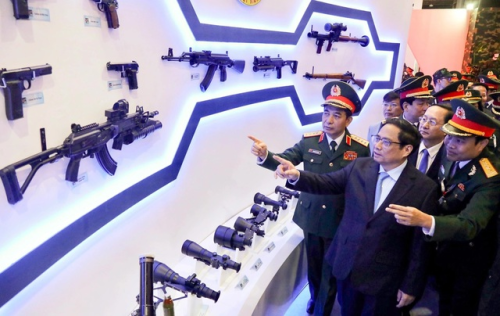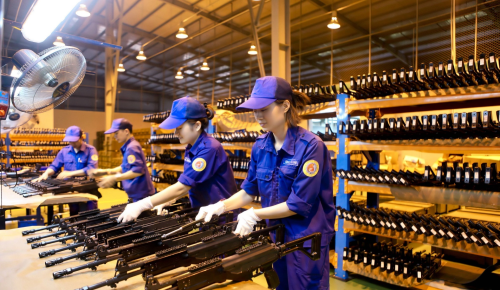The Party's thoughts on developing defence industry to meet the requirements of safeguarding the Fatherland in the new period
II. The solid development of defence industry and some issues
Based on a thorough understanding of the Party’s resolutions and directives on developing defence industry, the Central Military Commission, Ministry of National Defence (MND), and all-level party committees and authorities have consistently focused on comprehensively adopting various solutions to effectively carry out this important task. Significant results have been achieved, with some exceeding the pre-set objectives.
 |
| Prime Minister Pham Minh Chinh visits Vietnam International Defence Expo 2022 (photo: baochinhphu.vn) |
Notably, the system of legal documents for defence industry has been meticulously developed and continuously improved towards innovation, integration, and the enhanced effectiveness and efficiency of state management and administrative reforms. Investment resources have been increasingly prioritised, with suitable land allocated for defence industry development. A substantial budget has been mobilised from corporate revenues for investment and production. Many projects have been completed and put into use with high efficiency, resulting in a higher percentage of modern production lines and technological equipment and the increased capacity for producing weapons and technical equipment. In 2023 alone, the General Department of Defence Industry carried out 66 projects and 150 scientific and technological tasks at various levels, achieving commendable results. Special mechanisms and policies, along with national cooperation programs in science, technology, and industry, have been gradually perfected. As a result, resources for research, design, and manufacture of new weapons have been mobilised, while cooperation between military and civilian facilities, especially in conducting scientific and technological programs and projects for the development of defence industry, dual-purpose industry, and civilian industry has been improved.
The management system and defence industry infrastructures have been progressively consolidated. In the period of 2011 - 2021, the MND consulted the Government to transform Military Telecommunications Group into Military Industry and Telecoms Group, establishing several corporations, such as Ba Son, Song Thu, and Viettel Hi-Tech Industries. The organisational structure of defence enterprises has been streamlined. Numerous key research and design programs for weapons and technical equipment have been launched, marking significant breakthroughs in the capability to research, design, and manufacture modern weapons, namely missile systems, third-generation radars, automated command systems for air defence and air force, unmanned reconnaissance aircraft, small military submarines, command vehicles, armoured vehicles, anti-tank guns and ammunition, thermobaric and artillery shells, day and night observation and targeting equipment, new-generation communication equipment, cyber warfare tools, and simulation systems for tanks and multi-role fighter jets, among others.
 |
| Infantry weapons designed and mass-produced by Factory Z111 (photo: qdnd.vn) |
The production, repair, improvement, and modernisation of weapons and technical equipment have also seen significant advancements. Since 2011, the mastery of technology, design, manufacture, and repair of various modern types of weapons and technical equipment has been achieved in accordance with the operational requirements of the Army. Over 90 types of weapons, equipment, and ammunition have been developed for the infantry, with some reaching advanced global standards, such as Galil Ace 31, Galil Ace 32, STV 215, and STV 380 rifles. Nearly 30 types of military ships have been newly built, including missile frigates, gunboats, submarine rescue ships, coast guard ships, fisheries surveillance ships, troop transport ships, and hospital ships. The capacity to repair ships for maritime sovereignty protection has markedly improved in both progress and quality. Viettel, in particular, has produced many high-quality products, such as military communication devices on land, in the air, and at sea, national airspace surveillance system, digital radar systems with AI application for target processing and display, simulation systems for combat training, electro-optical systems for observation, surveillance, reconnaissance, and target designation using thermal imaging technology, drones, and numerous civilian products.
In line with the dual-use development policy, defence industry has proactively participated in producing equipment, support tools, and vessels for the People’s Public Security and other law enforcement forces. It has also produced many popular and high-quality civilian products, such as industrial explosives, fireworks, shipbuilding and repair, garments, and electronics, many of which have been exported, including crew supply ships for Damen Group (Netherlands), submarine rescue ships and oil tankers for the Royal Australian Navy, tuna fishing vessels for France, and various types of workboats, training aircraft ships, yachts, and tugboats, etc. Those have been exported to multiple countries, significantly contributing to socio-economic development in alignment with strengthened national defence and security, especially in border, sea, and island areas.
Due attention has been paid to developing human resources, particularly high-quality personnel. There has been an increase in the number of researchers, scientists, engineers, and highly skilled workers. As of early 2022, the number of technical personnel with doctoral degree had increased by approximately 2.38 times, and those with master’s degree by 2.24 times compared to the figures in 2011. Talented and potential research teams have been established in key areas, such as infantry weapons, shipbuilding, and research, manufacture, and production of missiles and hi-tech equipment. Additionally, comprehensive preparations have been made to mobilise defence industry for wartime tasks, with core defence industry facilities being re-arranged across all three regions in line with the strategic defensive posture. International cooperation in defence industry has been strengthened with diverse forms and content, such as human resource training, exchange of experience in state management and defence industry-related law, and technology transfer, thereby contributing to enhancing defence capabilities and protecting the nation early and from afar.
The 13th National Party Congress documents highlighted the achievements in this field: “Defence and security industry has been invested and developed, producing various means, equipment, weapons, and support tools to serve defence and security tasks, together with many civilian machinery and products that have secured a strong market share”. This reality demonstrates the Party’s sound and scientific thinking on building and developing defence industry in the new era.
Despite these achievements, awareness of defence industry building and development among some party committees, organisations, ministries, sectors, and localities has yet to be sufficient. Some still think that it is solely a task of the Army and military enterprises, leading to a lack of responsibility for building and developing this important field. Cooperation among ministries, sectors, agencies, and units in the implementation process has yet to be consistent or cohesive. A breakthrough mechanism and policy framework have yet to be established to create a legal corridor for the development of defence industry; the promotion of the internal potential of defence industry as well as the participation of national science, technology, and industry in defence industry has been still limited, etc.
The system of defence industry infrastructures has not been fully synchronised yet. Some enterprises’ management capacity has not met the requirements set by the market mechanism and international integration. Investments in defence industry from the state budget have been low. The capacity to design, manufacture, repair, improve, and modernise modern weapons and technical equipment for military branches has been still limited. There is a dearth of technical cadres, especially top experts in charge of researching and designing weapons and technical equipment.
Mobilising the potential of national science, technology, and industry for building and developing defence industry has been slow. International cooperation in defence industry development has yet to achieve significant breakthroughs. Trade promotion and product marketing activities have been still limited. Defence products have yet to be exported in bulk. The competitiveness and international integration capacity of defence industry has been low. According to Resolution 08-NQ/TW by the Politburo, the capacity of defence industry generally has not met the requirements set by the building of a modern Army; there have not been many dual-use products for civilian use and export.
The process of defence industry building and development has resulted in several issues that should be thoroughly studied and resolved.
First, defence industry development is a major policy of the Party. In addition to advantages, long-term challenges in this process cannot be solved overnight; hence, there should be great determination and decisive involvement from all sectors and forces in the development of defence industry. This is a fundamental solution aimed at creating synergy for building and developing defence industry in the new era.
Second, building and developing defence industry is a highly specialised task that demands significant investment in terms of finance, land, personnel, and technology. Therefore, there should be appropriate, synchronised mechanisms and policies to create a favourable legal corridor for concentrating, attracting, and mobilising capital, science, technology, and human resources for the development of defence industry to meet the requirements of Fatherland construction and protection in the new situation.
Third, developing a modern, dual-purpose defence industry as the spearhead of national industry is a sound policy; however, to that end, it is vital to master modern, dual-purpose technologies and develop high-quality human resources, especially leading experts and renowned chief engineers. In the medium term, there should be solutions for researching, designing, and procuring modern dual-purpose technologies, developing high-calibre human resources, and improving technological and scientific potential to turn defence industry into the spearhead of national industry.
Fourth, due to the robust development of science and technology, many powerful, highly precise, and modern weapons have been produced and are being increasingly utilised in conflicts. Military theatre of operations has expanded in various environments, including air, land, sea, electromagnetic spectrum, and cyber and outer space. The boundary between the front line and the rear is not clearly defined due to long-range, highly precise, and mobile weapons. This situation necessitates promoting the proactiveness, self-reliance, and resilience of defence industry, expanding international cooperation, and mastering modern technologies for designing, repairing, and improving a majority of the existing weaponry. Additionally, it is crucial to encourage research and manufacture of new-generation weapon systems of strategic significance and high deterrent capability to allow military branches and services to protect the Fatherland early and from afar.
Grounded on realities, experiences, and obtained results over the past time, all relevant branches and sectors, especially defence industry sector should work towards synchronised and feasible solutions to successfully realise the viewpoints, goals, and tasks of defence industry development, satisfying the requirements of Fatherland construction and protection.
CAO THANH - PHAM CUONG - MINH DUC
_______
Next issue: III. Solutions to foster defence industry development, meeting the requirements of Fatherland protection in the new period